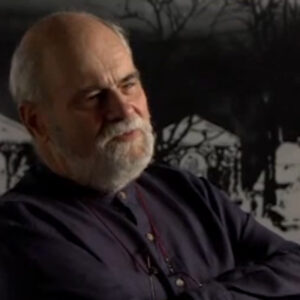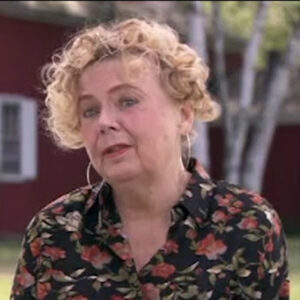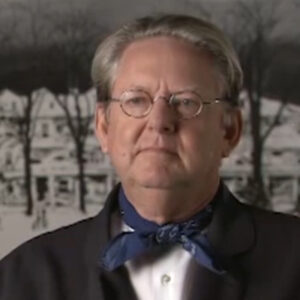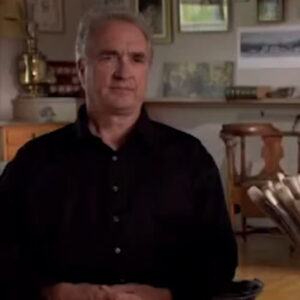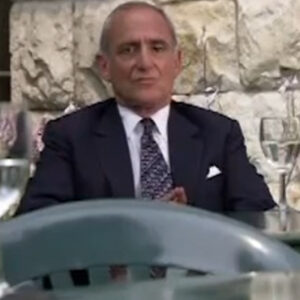Speaker So tell me about how you sort of traditionally thought, Rockwell, and how, you know, you sort of discovered him, if you will.
Speaker Norman Rockwell, for me and for lots of people of my generation, as well as younger generations, was just completely out of bounds. I mean, it was almost a dirty word in terms of the history of art. And this really had to do with the traditions of teaching, proselytizing, the cause of modern art. Norman Rockwell stood for absolutely everything that modern art was against in the first place. It had to do with mirror like realism. I mean, one of the marvels of Norman Rockwell’s art, which at the time was not thought to be a marvel, was how you could count every hair on the head of this grand old man in the foreground or look at the mirror in the picture, which really had a reflection, like a real mirror, et cetera. So that was that, because the whole point of modern art was not to be a mirror image of the things we see, but something else, a an abstraction of it or an interpretation of it, et cetera. And then another thing that made him absolutely the enemy with Capital E was the fact that he told stories. This was another thing we learned about modern art. Modern art was not supposed to tell stories. It was not supposed to be literature. It was supposed to be something pure and visual. It had to do with things that were aesthetic, things that were lofty, things that transcended the daily facts of life and pictures that told stories were absolutely on the bottom of the pecking order so that in every possible way, too much realism just mirrored truth. Too much storytelling and usually cute kind of storytelling. Norman Rockwell was out. And then, of course, the thing that made him the real enemy was that when the cause of modernism was still on fire, this was a an elite point of view. This was the minority view. And you had to be very, very passionate and intelligent and trained in order to go to sanctuaries like the Museum of Modern Art. Whereas Mr. Rockwell was one of the most popular artists of the 20th century and every American loved him and there was absolutely no problem in drawing him. So that at that time, popularity almost meant that the artist was beyond the pale. He couldn’t be a good artist if he was liked by everybody who bought the Saturday Evening Post. So everything was against him. But that we’re talking now about the middle years of the 20th century when I was educated.
Speaker And all of the battles for modernism have long since been won. So that works of art now that are realist or hyper realist, that tells stories no longer look as though they are on the other side of the barbed wire, separating high from low or good from bad or popular from the elite. They just look like something different. And it’s quite fascinating to realize that these reassessments in terms of the history of 19th and 20th century art probably began with people looking for the first time again at, say, Victorian paintings. There were many 19th century paintings that were Predecessors’ to Rockwell. I mean, they told stories and you could see the facts of domestic life, people going bankrupt, people committing adultery, people having babies, people attending funerals. And all of this took place within a cosy domestic setting. And there were highs and lows of tragedy, sort of predictable soap operas. And all of this was rendered with an absolutely faithful, meticulous realist style that was virtually the equivalent in paint on canvas of a photograph. And people began to look again at such 19th century paintings. And slowly they established their own pecking order. That is, they were terrific artists, who tells stories in a way that the best novelists would tell a story. There were artists whose version of realism was more intense, more exciting, more sharp than others who were routine. And our eyes once again became attuned to looking at what for a long period had been a kind of extant world of pictorial experience.
Speaker While just fooling around. What about the tradition of, say, the Dutch masters going even further back?
Speaker I mean, it’s very. And this has to do with history and ancestors, that is there has always, of course, been art that told stories with a meticulously realist style and the most conspicuous place would probably be in Holland in the 17th century. And never did anyone stop revering Peter to hope roomier. But somehow this all seemed long enough ago not to be a threat. Whereas art of the present, that is the 20th century, or even our grandparental period, namely the 19th century or great grandparental was a little bit too close to comfort. That is this was the immediate background, the immediate enemy that had to be conquered, annihilated, swept under the carpet in order for modern art to make its points so that it still was alive and well. And its still have the kind of sting, the venom that represented in a living or almost living opponent.
Speaker And you were part of this battle, if you will. Right.
Speaker Well, in personal terms, I was on both sides of the fence. That is, I was a passionate evangelist for modern art. And the first art I loved as a child, as a teenager, as a student was the art of people like Picasso, Miro, Mondrian, what has now become the canon of 20th century masters.
Speaker But I also had, as it were, a kind of closeted side, which had to do with a love for certain kinds of hyper realism, really intense, crazy, obsessive realism in which you could read the title of every book on the shelf, that kind of thing. And I also was fascinated by the possibility of art telling stories. I mean, different artists have different powers of storytelling and some of them are hacks and some of them are geniuses, just like writers who fictions or direct fiction or directors of movie.
Speaker So slowly, stealthily, I began, for instance, to be attracted to a Victorian painting, the best of it. And I have to say that in terms of the topic today, Norman Rockwell, I was very, very slow in coming around, but probably had to do simply with lack of exposure. He is an artist whom you see, at least if you do the usual museum rounds. And I had a kind of preliminary Eureka experience. It was, I think, in the late 70s, early 80s. In any case, a long time ago. And I walked into the Wadsworth Athenaeum in Hartford, Connecticut, a great museum to see their collection. And suddenly on the wall, there was this total outsider, this alien painting, and it was by Norman Rockwell. And I thought, you know, what on earth is this picture doing here? And it was certainly interesting in itself, but it didn’t look like the Mondrian. The because of the Matisses round the wall. And then my sense of historical fairness began to take over. And I thought, well, after all, this is a painting that’s done in the 20th century. It represents a large constituency. Its style may seem to be off the map in terms of what we think is true and valid and beautiful, but it nevertheless exists. And why shouldn’t I pay as much attention to this in my role as a serious historian as I do to anything else? And the picture, you know, just kept nagging at me. That is it just upset my prejudices. Like, why was I disturbed by this or why should I be or why shouldn’t I just plain enjoy it? Which picture was it? It was a picture, I think of a. Was it a little girl waiting in a doctor’s office? I think that’s what it was. She had a black eye. I may be confusing it, but it was a narrative about the usual cute kid in the usual Norman Rockwell situation of not such serious distress. But that was, you know, something that was buried in my conscience. And I totally forgot about him until a couple of years ago. Must have been 1996 that I almost by accident was in Stockbridge, Massachusetts, and went to see the museum. In a way, I was actually more interested in seeing the Robert Stern building than the holdings, but I was there and I’d never been there before. I walked in was for me, like discovering a whole new planet. I had to confess that these pictures were riveting. I probably looked at them longer and more carefully than I looked at pictures in the Louvre. The Prado is really a fresh, exciting experience that I was absolutely dumbfounded by how fascinating they were. They were not only fascinating in terms of the intricate layers of narrative, the way things just the food on the table would somehow symbolize something or the particular tie that somebody wore seemed to connect with that social message that all of that was interesting. But there was this intense, sharp focus, reality from every square inch of the canvas that had a kind of crazy realism that sort of transcended ordinary vision and moved to a nother plane in which every little detail somehow told a story or rang more true visually than it does in ordinary experience. And I was totally mesmerized, which I guess translates into a kind of conversion like this is an artist of consequence. And we’ve all had our heads buried in the sand. And isn’t it time we just stretched out and relaxed and admitted that this was somebody worth looking at and thinking about? And of course, there are there are many ways of looking and thinking about him.
Speaker And one of them has to do this to say with the fact that these days, in the later 20th century, art is always for many spectators and riders, a barometer of culture.
Speaker So that just in the same way that we get all fascinated and gooey and nostalgic looking at Victorian paintings because their time capsules of a No, the World Day, another way of life, other mores, other attitudes towards family, society, you name it. And the same way Norman Rockwell presents an extraordinary panorama of any number of myths about American society. So that just as a cultural document, he is an artist who merits all kinds of attention.
Speaker You could learn more about the myths, usually total fantasies of America that were floated throughout the first half of the 20th century by looking at his work than you probably could from reading dozens of novels. But it’s all there.
Speaker Give me some examples. Yeah, I.
Speaker We are. What kinds of mess?
Speaker Well, for one of the extraordinary things is that not that extraordinary is that he really presented the most clean version of Americana until in his case, work was virtually a conversion to political consciousness in the 50s and 60s. But before the Second World War, everybody was clean, scrubbed.
Speaker The worst violation in terms of criminal law would be, for example, a bunch of kids who are ignoring a no swimming sign and who take a dip bare ass when they’re not supposed to be on the property. That was his idea of criminal behavior and has interesting analogues, say, with the children’s books that were written at the time, things like Booth Tarkington is Penrod, but at present it’s still this fantasy of a very clean and very white Americana in which family values were preserved.
Speaker There are pictures of the cherished holidays, Thanksgiving, Christmas, of course, and there is always the sound of church bells in the background so that you feel that this family is pious enough to get it together for Sunday, even though there are little nods toward reality. For example, the father of a family may be staying home while the mother and children go off to church. But it was the most sanitized vision of America and it also was based in some part on fantasies about colonial America. There was that sense of the purity, the sort of Dunkin Donuts aspect of the 18th century, so that everybody was prim. They lived in a little white painted houses and everything was spic and span clean and there was absolutely no social unrest. But one of the fascinating things about Rockwell, I mean, I would be happy just to look at this as the complete statement of a complete myth. But most extraordinary is that Rockwell cracked through these boundaries of what Americans like to see reflected about themselves. And in the 1960s especially, he produced images that are, I think today still among the most shocking commentaries, visual commentaries on the racial problems of this country back in the 60s, especially the whole issue of segregation. And he did, for example, an unforgettable painting and illustration.
Speaker It started off as an illustration of the little black girl, Ruby Bridges, who had to be accompanied to a school for integration with the whole police squadron body bodyguards. He did pictures of civil rights activists and this in the south who had been shot or injured. And these are, I think, appallingly true documents that suddenly speak about the ugly facts of America as opposed to the whitewashed candy box images that he had painted before.
Speaker What do you think accounts for that change? I mean, do you think he lost belief in the method of painting or what do you think?
Speaker I really don’t know what prompted this transformation in his political consciousness. I think at the beginning he was really working for a predictable market and knew what the public wanted and could provide it. But he also, as I understand it, had endless aching doubts about his own persona as an artist. That is, he was immediately classified as an illustrator and that to him.
Speaker And still, I think to us today means a second class citizen in terms of artist hierarchies. That is not high artist, not a painter with a capital P who belongs in the Metropolitan Museum and the Museum of Modern Art. But somebody who panders, as it were, to a large public. And I think that as he grew more and more famous and successful, he began to follow his own instincts, in this case, political instincts, and have the courage to illustrate relatively late in his life. Some of the blackest truths about American society. It’s quite an extraordinary conversion. I don’t, however, for a minute mean to imply that these works are necessarily better than the earlier works because somehow they are honest exposes of the ugly side of America. There’s something else. But I think that they probably could be used if one is interested in converting high minded people to Norman Rockwell.
Speaker Probably be used as means to realize that he is not just someone who constantly gives the public what he what they want rather than Heynckes what he genuinely feels. But I must say that in terms just forgetting about the political awareness of his later work, in terms of the first half of the century, I kind of love it. It’s a miniature fantasy world about America that was constructed by him and by his audience. And it’s fascinating, say, in the way that movies of the earlier century tell us so many stories about the rights and wrongs, the ups and downs, the happy endings that presumably were part of American life. And it’s when you look at Norman Rockwell, it’s almost like being Gulliver going to another planet and looking at all of these strange people who happen to be Americans but who really are living in some kind of Ballajura fantasy world, which is totally consistent, totally coherent, has its own laws and is a structure into it unto itself.
Speaker So I’m sort of out of one side of our mouths. We may sneak around and laugh at the same time it tugs at us. I mean, it’s this sort of conflicting emotions.
Speaker Well, it’s a very strange world because, I mean, it’s very easy to recognize the falsehood of it and the artificiality of it. But it’s also in a curious way, it’s so airtight a world. It’s almost like, well, for example, this may be a big stretch, but the world of a Jane Austen novel, I mean, it’s just hermetic. It’s got its own rules, regulations, and it exists within a kind of bell jar. And we peer in and we know what the structure is and we know what’s going to happen. And, you know, once you accept that as a premise, then it’s totally fascinating because there are so many variations upon it.
Speaker And his skill at painting is super realism, probably added to the power of the fantasy. Right. I mean, yes.
Speaker And another thing about him, you know, talk about virtual reality these days is that his craft at just replicating things seen with obsessive detail is another way of persuading the Spectator that this is real.
Speaker I mean, it’s so real that you can see it and touch it. It’s like looking glass real, except that it’s totally impossible. It’s a complete fantasy. And it looks accidental and casual. But everything is as calculated as you could imagine in any work of art. I mean, there’s hardly. That’s one of the fascinations of Rockwell noticing not only the major facts of the story, the big people in the foreground, but then roaming around and looking at how every single detail clicks into place so that the sheer amount of control of calculation, of planning, of meaning and the work is so infinite. I mean, it’s really quite staggering to see how much intelligence, how much planning, how much thought, how much symbolism to use. A loftier word is involved in the making of the most familiar Norman Rockwell painting.
Speaker So his work was a lot more complex than our initial image of it. Would you say?
Speaker Yes, my my sense of his work is that it is just endlessly fascinating because of its complexity. I mean, I am thinking, for instance, of a fascinating analogy. There’s a famous Victorian painting called The Awakened Conscience, and it’s a picture of a woman who suddenly realizes that she’s living in adultery.
Speaker She’s unmarried and she’s seated on the lap of her boyfriend. And this, of course, was an outrageous transgression in the mid 19th century when the picture was painted. And when you look at this picture, which is by Hohmann Hunt, you suddenly look around and you see that there are all kinds of symbols that relate to the moral tale. For example, there’s a cat that is toying with a little bird and the cat’s paw is in the same position as the gentleman sleeved arm as he’s holding it around his mistress, whose moral sense is suddenly been quickened. And there’s a glove on the floor, which might be a symbol of the first flirtation needle work that has been left unfinished, etc. So that when you look around the picture, you realize that everything which just looks like domestic scat or an accident tells a story. And a lot of artists did that. But it really is the degree of the intensity of the imagination of the artist in pulling this off. And Norman Rockwell is absolutely amazing at this, especially in view of the fact that when you first look at the picture, it just looks unplanned and ordinary, just a casual scene at Thanksgiving table or folks sitting at home or not sitting at home, going to church, you name it. And then you look around and you realize that everything says something.
Speaker For instance, there’s a fabulous picture of nineteen forty nine, which is one of the watershed moments in American history. Namely, it shows a man installing TV antennae on his roof. And that’s a kind of ordinary thing, except that the dating is wonderful. It’s 1949. It’s just that the moment when TV began to swamp the United States and the rest of the world. And what is being shown is just an ordinary guy doing this awkwardly. But the roof that he’s putting it on is a gable of a Victorian house. So it just quietly suggests the contrast between old and new and to make things even better. Somewhere in the distance of this Americana town where he lives there, there’s a church steeple in the background silhouetted there. And it very subtly rhymes with this newfangled church steeple, which is a Victorian domestic cable TV antenna, so that in this very, very stealthy way and there’s much more in it. Of course, Norman Rockwell tells all about the history of American culture moving from sacred to secular, from the church to the domestic, you name it. But that’s the kind of stealthy imagination he has in terms of what he chooses to depict.
Speaker Once they simply. Ellis, I’m sorry.
Speaker I hope so.
Speaker I want to talk more about art versus illustration. And what was Rockwell, in your view? And, well, let’s start with that. I mean, was he an artist? Was he an old spider web?
Speaker The question that Norman Rockwell kept asking himself was, well, was he merely an illustrator or was he a genuine artist? And in his mind, and I guess according to 20th century categories, there was a quantum leap between these two categories.
Speaker And I think he always yearned to be an artist with a capital A the kind that went into the museums as opposed to covers of magazines like the Saturday Evening Post. And certainly in terms of the hierarchies of the that were inherited and that were believed in the 20th century. There is a great difference. The difference, I guess, has to do with the fact that if you’re just an illustrator, just it is a loaded word. If you’re an illustrator, then you are presumably the slave to a text, to a story so that you are not the inventor, but you are the one who follows somebody who has told a tale and it’s up to you to depict it. That, of course, is of ready threatened by Norman Rockwell and so far as he invented his narratives or his situations so that if he is an illustrator. There he is, at least illustrating his own fictions as opposed to somebody else’s. So if you want to maintain that pecking order, that gives him one step up the ladder. However, it seems to me that the distinction between an artist and an illustrator probably is a dangerous one in so far as it immediately implies. If we go on with the this assumption that somehow an illustrator is instantly inferior to an artist, and in fact there are artists whose illustrations to literature are classics in terms of high art. I’m thinking, for instance, of Aubrey Beardsley, who illustrated Oscar Wilde’s Salomé for one thing or Picasso for another, who illustrated Greek classics like With Strata or who illustrated Bouffe Fons, Animal Books, Animal encyclopedias, so that even artists as illustrious as Picasso often find themselves in the role of illustrators.
Speaker So they’re not it’s not mutually exclusive, but it is one of those assumptions that I think should be muddied in the sense that the whole sense of one kind of art being superior to another, for instance, the decorative arts somehow being inferior to painting and sculpture. This is an idea that’s been much challenged in the late 20th century and probably for the better. I mean, for instance, there are sculptors now who make sculpture out of furniture. They’re inspired by furniture forms. Are they decorative artists or are they sculptures? They may utilitarian furniture. Are they making non utilitarian abstract sculpture? That’s just one example. If an artist makes wallpaper, does that immediately mean that that artist is somehow superior to some inferior to somebody who makes oil on canvas?
Speaker And I think the whole tendency in the late 20th century is to challenge these assumptions about good, better, best growth is low and high.
Speaker And the question of an illustrator belongs to this category. I mean, one could, after all, say that Alberich Dora, if he did woodcuts illustrating the Book of Revelation, is just an illustrator to the Bible as opposed to a high artist. So the more one thinks about it, the more the categories become confused. And the airtight division that Norman Rockwell suffered from is one that probably should be exploded.
Speaker I mean, why, for example, do we respect. Don’t. Or even Sendak. And why respected Rockwell? I mean, why this why. Why the disdain for what?
Speaker It’s quite interesting that there are any number of artists.
Speaker Domina is a first rate example who is a wildly popular illustrator. He had a huge audience and the Paris readership of the mid 19th century who would look at his images of daily life. And he was a illustrator. But somehow we in the 20th century believe that his illustrations somehow transcend that moment in which they were topical and printed and sort of tell us about universal experiences, as well as particular experiences that deal with life in mid 19th century France. So there are any number of examples from the historical past that could support the credentials of Norman Rockwell being more than a mere illustrator, which is how he saw himself.
Speaker How do you put Rockwell context with, first of all, American real estate? Why, of course, are even more modern. I’m probably violating the correct terms, but David Hockney works from photographs.
Speaker Talk a little bit about how one of the fascinating aspects of Rockwell is, in fact, his realism. That’s a terribly loaded word, which means different things to different artists and people. But just looked at the most pragmatic way. It means something like what you see in a mirror. Closer to that than farther away. And this insistence on the fact s they’re on material facts is something that has been a constant in American art. It’s, of course, just a constant of human experience. But I would say at least that in terms of the traditions of American art, much of the 19th century as well as the 20th has been very, very rooted in this sense of these specific. For something that is actually observed and something that is really tangible. There’s a flip side of the coin, too, about space and light. But if the this side of it has to do with things that you can reach out and handle and people who have very, very particular recognizable faces and this is, of course, something that’s found constantly in 19th century painting and in particular in the 20th century.
Speaker The most conspicuous case being, of course, Andrew Wyeth, an artist whose popularity probably vies with that of Rockwell, although, unlike Rockwell, he’s got into lots and lots of museums. Rockwell is still in his own very clean ghetto up in Stockbridge.
Speaker Why that separation? I mean, is I mean, does Rockwell fit into some sort of continuum in American art?
Speaker Or I mean, why don’t.
Speaker Or I mean, I guess I’m asking is I mean, should we think of Rothwell’s in relation to any of these other well-known 20th century? Ah, yes. Or something sort of hard.
Speaker My my own hunch about Rockwell is that at the moment and certainly before the late 20th century, he was always segregated from serious artists of the time and even popular artists like Andrew Wyeth, whom presumably right. Thinking modern art lovers hate. Even he has been represented constantly in museum collections and traveling exhibitions and so on, which is not the case with Rockwell, with very rare exceptions and for the time being. Rockwell, of course, has his own shrines and sanctuary and the museum in Stockbridge. But my prediction, I don’t see the like, crystal ball reading. But my hunch is that in 20 or 30 years, he will have left his sanctuary and left his low straight home of popular illustration and B, slowly, maybe even rapidly absorbed into the history of 20th century art.
Speaker And it’s already begun to happen, for instance, with other quote unquote, illustrators like Maxfield Parrish. He is another artist who is kind of on the brink, who used to be thought of as only someone who did the kind of pictures that would be appreciated immediately by an audience that put this or that magazine or needed a popular print to decorate the living room. But as time has passed, his credentials have grown and he has spread in many directions so that he represents all kinds of dream world fantasies familiar to the beginning of the 20th century. But Rockwell, I think, will also begin to shed his shackles of illustrator ship popularity, that kind of thing, and will be integrated into a more general and a more tolerant history of 20th century American art. I mean, I, for one, could no longer conceive of writing a history of 20th century art that would not include Norman Rockwell, although in fact, I would guess that statistically there barely was a history of 20th century art until now. That did include an.
Speaker Is there any direct comparison to be made between him and, say, hockingsi? This is both working for or is it too far fetched that now is our other other inheritors to Rockwells tradition? I mean, did he continue on? It goes past.
Speaker Well, you know, another interesting it’s funny because once one begins to think about the Rockwells situation, it’s like discovering prejudices that we’ve had unconsciously and never really examined.
Speaker And once you start to think about, well, why not Norman Rockwell or why is he different from an illustrator like DOMA? Why doesn’t he deserve a fair shake, too, etc.? Then other later names begin to get into focus, for instance. There is the case of Ben Shahn, who was mainly active in the 40s and 50s and who at the time was a very, very popular artist who very much like Rockwell, had an extraordinary social conscience.
Speaker And he wanted his art to get to the people and to tell messages about social rights and wrongs. And he really wanted to reach everybody. And for a while he actually did.
Speaker And then with the triumphs of modernism, abstract expressionism in this country, he was rather belittled, swept under the carpet. And it’s only now this is quite topical in terms of Rockwell revival, only now suddenly been dusted off and looked at. So that I think that within the coming year there’s going to be a Ben Sean retrospective. And when suddenly realizes that these artists who seem to have been buried with the cultural past can have a new life, they can be resurrected. And sometimes they’re fascinating only really as mirrors of cultural history. But one of the great things about art is that it is a mirror of history. And we can learn a lot about what people felt and thought and experienced by looking at the art is something we learned from Rockwell, and it’s certainly something we can learn from Shawn.
Speaker I’m sorry, but you’re also saying that Rockwell went beyond being a mirror of history. I mean, you’re really saying kind of what he invented on American world, right?
Speaker Yes, it’s. Well, Norman Rockwell could, I think, be credited with giving visual form to a an American fantasy. I mean, he really established created Planet America. It’s a kind of Disney World before Disney World. And it’s someplace where you can live and breathe and eat and you know that everything is going to be predictable and everything is going to come out all right. At least that’s the vision of America that he provided in the first half of the century. And it seems to have given an awful lot of people comfort and may have been false comfort, but then so was a lot of art of the past.
Speaker But he really, as you said, he really did have ambitions beyond being an American myth maker when he really wanted to be in that continuum of art history.
Speaker How did that. Right. Yeah, he taught me he actually, as I understand it.
Speaker Well, he he went to Paris and he studied art there. And I think for that time had the ambitions of transcending the traditions of popular illustration.
Speaker And he is known to have been very favorable, very positive about even artists like Picasso so that he really knew the history of art.
Speaker And I think he aspired to the highest ambitions for a time.
Speaker But he was, after all, a Real-Life person who had to make a living was wildly successful at what he did and did it regularly like a journalist. I mean, I guess it’s almost the equivalent of a crackerjack journalist who longs to be a the writer of the great American novel, but has to grind out his copy every week and never gets around to doing the real thing and feels as though he’s been defeated.
Speaker Can you give me a few examples of how Rockwell quoted the old Masters or.
Speaker Well, one of the interesting blurs in the boundaries between. Rockwell and the presumably high art of the museums is in a self-portrait. He did it’s very, very telling because he has a kind of jokey picture of himself painting his own portrait. And he sort of stumped before the canvas. But tacked up all around the canvas are self portraits by the old masters, including Van Gogh, for example. And it is a kind of art history anthology that makes you realize that he knew as much about art history as anybody else and that he had these great duties in mind when he painted.
Speaker And on a completely different wavelength, it’s quite apparent that he was in touch with the history of modern modern art. For instance, there is a famous Norman Rockwell in which he reproduces a painting by Jackson Pollock. Well, he doesn’t exactly reproduce. It invents his own Jackson Pollock. And he apparently learned how to pour, paint and scatter.
Speaker It’s the way Pollock did in this rather fascinated him. And he made a fact. Similarly, Pollock and then painted it, hung up on a wall. And we see the back of some sort of discombobulated spectator puzzling over it so that he was really not an enemy of modern art, the way friends of modern art were enemies of his. But somebody who followed its course and who was even able, if necessary, to replicate it.
Speaker I think he once said he wished he could paint like Picasso. I wonder, do you think he probably. Well, tell me about that. Yes. Tell me about what he I to say. He did.
Speaker He did. Presumably once say that he wanted to wish he could paint like Picasso. And I think he probably meant it. Whether he could or not is another matter. But why should he paint like because he had completely different gifts from those of Picasso. But I think, for example. Well, he certainly knew Picasso’s work. And in fact, there is one of them quoted in the self-portrait he did. A Picasso self-portrait in it. And he just copy that. But I think that sometimes he may even be making very, very stealthy allusions to the old Masters. Picasso included. And one of his corniest and most enduring pictures shows a very, very young girl, I guess, on the brink of puberty. And she’s looking at herself in the mirror, trying to primp up and look like a Jane Russell glamour puss girl. She’s got it. In fact, a photo of such a movie type on the floor next to the mirror. But I think my own hunch is that it’s his own version of the famous Picasso girl before a mirror, which is done, of course, on a highly fraught Freudian level of simple and so on and unreality. Whereas Norman Rockwell is the American homespun version of this exploration of a young girl’s psyche that I translated.
Speaker Michelangelo.
Speaker All right. Yes. All right.
Speaker Another extraordinary spoof, as it were, on the old Masters is when, Derf, for the spirit of the war, he did a picture of the very image of the conscious conscience, raised an American working woman who has become a riveter for the war effort. And she’s seated in this very, very muscular posture in what is a very close paraphrase of one of the profits from the Michelangelo’s Sistine Chapel ceiling.
Speaker So this is no his own way is both. It’s a little bit poignant. It’s both a a an indication of the fact that he knew the great Masters and was knowledgeable on that level like a serious artist.
Speaker But at the same time, what he could do with it, it turns out to be a kind of Americana’s spoof of this pose. So that in a way, he’s both showing off and putting himself back in his modest place, going back of a triple self-portrait.
Speaker What do you think he was saying in that painting?
Speaker You know, he I think he. Often had these spars with the old masters, and they were really, I guess, in a way therapeutic for them because in the self-portrait where he is in fact rivaling the old masters and showing you the genealogical table of art history, self portraits that he wants to include himself in, he’s both saying that I know about this, but I also know my proper place in the history of art. And I’m never gonna make it so that you come out with a kind of sweet and sad smile when you look at the picture, which is probably the way he felt.
Speaker Somebody said there was a house stand dimension to Rockwell. Arthur Danto, actually. Really? He was he couldn’t resist trying to please his audience. And that was his downfall. I just wondered what you mean. I mean, that is a common criticism. I mean, whenever they had a caricature, you know, couldn’t resist going for a laugh. I mean, do you think that’s a fair criticism?
Speaker Well, I don’t know. I probably should take the Fifth Amendment. I don’t have strong feelings, but it’s very interesting. I never thought about it before. To be honest.
Speaker So I don’t know if I can go with that.
Speaker But I’m with you on a personal level. You don’t respond to his work as character? No, I don’t.
Speaker I mean, I certainly I certainly think that his work is totally aware of an audience out there and knows how to fulfill expectation. And it’s almost comparable, say, to the role of a terrifically successful TV script writer who knows what his audience wants and produces every week the next version of Frasier or Seinfeld. But that said, that immediately suggests as well that there are hierarchies within TV comedy or TV soap opera, and some of them rise to very high levels.
Speaker Slight diversion. I know you wrote about the iconography of dogs. I think dogs and Rockwell just wondered if you thought about that.
Speaker I know is my Rockwell days are post dog it. I better get back and look at the Rockwell dogs in that. Interesting. I never really thought about. I mean, obviously there are dogs there, but I can’t get them into focus, but I’m sure they tell a story. Well I got to go back and go look through my Rockwell book.
Speaker You have a favorite Rockwell or favorite Rockwell.
Speaker Well, I think. I think one of my favorites actually is the 1949 TV antenna, because it is I enjoy Rockwell for many reasons, but one of them is the way he manages to put his finger on the pulse of American popular life for real life, even though a lot of it is so coated. And this one is just extraordinary. He seems to have chosen the exact moment. It’s the watershed of American popular culture, the transformation from B, C to a D before television to after television. And he exactly pinpointed this at the right time. Nineteen forty nine and with the right image and it just soars looking backwards to the early 20th century and beyond. And then forward to the world we live in. So I think this is one of the great watershed pictures of, of his career and of American history.
Speaker Of course he did both reflect American culture in a sense, but he also had an impact. Parmeter helped create it. Right.
Speaker Yeah. I think, you know, it’s his relationship to his audience as a kind of chicken and egg thing. At some point, you don’t know whether he is inventing myths that the audience buys or whether he is just reflecting myths that the audience created. And I think, you know, it’s the same problem with lots of popular art.
Speaker I mean, the movies would be the most conspicuous example, whether the producers are inventing something that the audience wants or whether the audience has half invented it for the producers, because if it weren’t in their heads already, they wouldn’t quite buy it.
Speaker Do you notice Rockwell imagery, though, today, say, in movies, advertising? I mean, we that’s sort of part of our American. Culture of this world that he created or invented?
Speaker Well, you know, one of the most conspicuous survivors of his very endangered species is almost more than a survivor, but a very vigorous revivalist.
Speaker Namely, Main Street, Disney World. And all you have to do is go through the turnstiles at Disney World and you see a total fantasy of a completely lost Americana that Norman Rockwell tried to preserve. And that is, in fact, in some way preserved in Stockton, suffrage, Massachusetts.
Speaker And this is for everybody to see whether it’s in Orlando or Anaheim, California, or outside Paris or Tokyo. But just this nostalgia for an American past with a soda fountain and with horses and buggies and. Absolutely. And polluted snow and rain. All of this is something that has been again and again reconstructed in the late 20th century as a Americana dream world.
Speaker Our ancestral figures, I guess in architectural terms, writer Robert Amsterdam dealt with that iconography in the museum. Right. Can you talk about.
Speaker Yes.
Speaker This image of the American past, a kind of colonial purity in some cases, or a Victorian picturesque charm. This is something that the architect of the Rockwell Museum, Robert Stern, really put his finger on so that the it’s the I love the building and it’s exactly appropriate. And it says a perfectly clean weiden. Purists say the Jefferson Memorial in Washington, it conjures up that whiteness, sanctity, chastity, purity, you name it, that we associate with these the long ago DTD. And it also has a specific early 18th century shape and language. But that said, it goes far beyond that because it is very, very shrewd architecturally and has all kinds of delicious details that are much less simple minded than the sanctuary. Look, the building suggests. So it is a very, very savvy that building. And I think an absolute the perfect envelope for the contents, because Norman Rockwell, too, is much more complicated than he seems.
Speaker How about the image that’s behind us? Wonder and Stockbridge?
Speaker Well, we have to remember that Norman Rockwell, especially in terms of the high holy days of America, Thanksgiving and Christmas created all kinds of images that have been translated umpteen times into greeting cards. I mean, it would be impossible to go shopping for a Christmas card, at least the traditional kind, as opposed to the contemporary ironic kind that it didn’t look like some kind of branch off Rockwells tree. So that just as he could depict the perfect American Thanksgiving, the perfect American prayer service, he could also depict the perfect American small town, which always turns out to be New England and the snow. And there is not a McDonald’s in sight.
Speaker Greg, as we’ve said, he may have fallen short of success in his own eyes in some ways. I mean, I don’t even know if that’s a fair statement. I mean, do you? How do you think he should be viewed as somebody as an artist who reached full achievement or somebody who felt a little affordable?
Speaker Norman Rockwell probably had other aspirations for himself. But the fact of the matter is that, you know, now that his work is complete and he’s gone, it is very hard to imagine him doing anything other than he did. But the truth also is that he broke his own mold already in the 60s.
Speaker I mean, he did works that were really shocking and violent in a way that was totally unimaginable. It’s almost as if he had lived in the Garden of Eden for the better part of his life. And then suddenly he was expelled and there was the first murder, the Cain and Abel story, so that this possibility of change in his work, emotional change, moral change and visual change as well, was in a way realized that probably he himself didn’t feel that this was enough and that his aspirations could have been better fulfilled. But after all, it’s like every other artists work. I’m sure that even the greatest artists in the canon may have thought that they could have done something better, different if they had lived longer or had more energy, passion, you name it. So it’s just a human story. I’m very grateful to him for what he did do.



